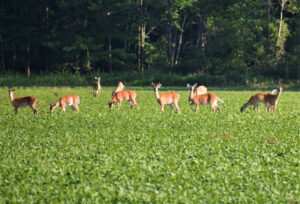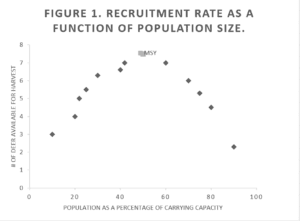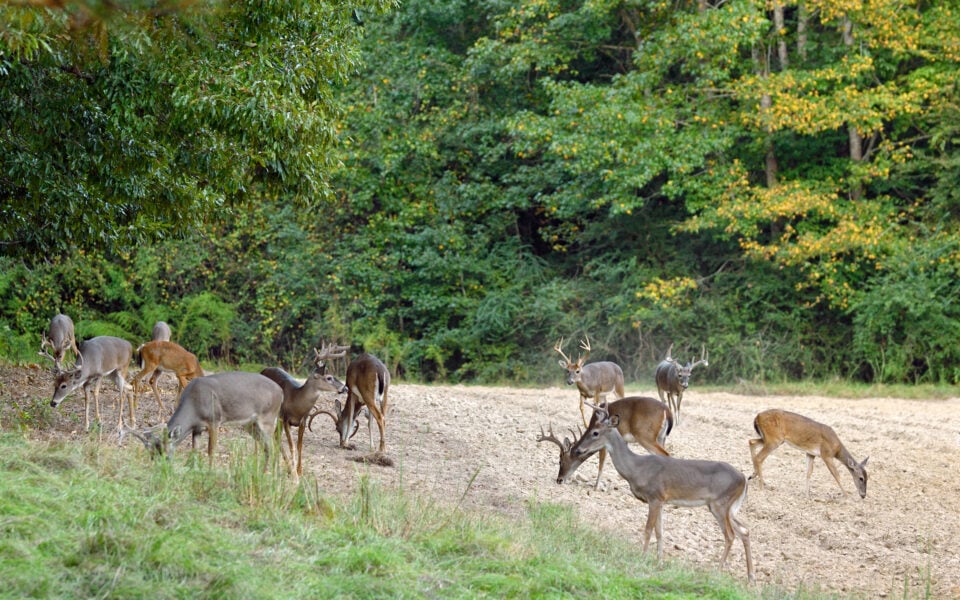Thanks to changes in attitude resulting from the boom years and a plethora of research, deer managers have become much more conscientious and sophisticated. A lot more consideration is given to balancing quality and quantity, but we still sometimes push the limits in trying to maximize both. But there are consequences, and in order to better understand them we must first understand the fundamentals of managing deer herd density.
Basic Principles of Wildlife Management (Ps and Ks)
As most folks know, carrying capacity (K) is the maximum number of animals of a given species that an area can support without any habitat degradation. Once K is determined for a particular area, that area can theoretically sustain a population (P) of that size indefinitely, all other things being equal.

However, all other things are seldom equal. All things in nature move toward entropy (disorder). Extrinsic factors like weather, climate, disease and human intrusion and development can all confound things, which is why you must continually mind your Ps and Ks.
Another concept to be familiar with is sustained yield (SY), some proportion of P that you can remove and still be guaranteed of having a similar amount available in successive years. The amount you remove is replaced through recruitment (immigration and reproduction).
Recruitment Rate
Recruitment rate the ability of a population to replenish itself – is density dependent. An example of the low end might be a situation where there are so few adult animals that the number of animals being removed by predation exceeds the number of fawns being born to replace them; mortality exceeds recruitment. This situation is called a “predator pit” and without some outside influence, like predator control or a disease outbreak among predators, the deer population will never grow and may continue to diminish.
 At the other end of the spectrum is overpopulation. As a population grows, recruitment rate increases, up to a certain point. If you were to graph this it would appear as a rising curve (see figure 1). But as the population grows beyond this point, density dependent factors like increased stress from interspecific interaction and habitat degradation from too many mouths negatively influence the population and recruitment rate declines as a mirror image of the previous growth.
At the other end of the spectrum is overpopulation. As a population grows, recruitment rate increases, up to a certain point. If you were to graph this it would appear as a rising curve (see figure 1). But as the population grows beyond this point, density dependent factors like increased stress from interspecific interaction and habitat degradation from too many mouths negatively influence the population and recruitment rate declines as a mirror image of the previous growth.
Intuitively, you would think your objective should be to maintain your deer population at K – the maximum number of deer the habitat can comfortably support. However, what we’ve learned from studying both population models and real populations is that in order to achieve maximum sustained yield (MSY) – the maximum proportion of deer you can annually remove from a population on a sustained basis – you need to maintain the population at about 50 percent of the carrying capacity (5PK). This can be one of the most difficult concepts to grasp and to accept, but your deer herd will have its greatest productivity, and provide the most animals available for harvest over the long term if you can keep it around 5PK.
Achieving Heard Balance
When things get out of balance, which in most cases is because the population is too high, there are two ways to achieve balance between P and K. One is to reduce P through trigger finger management. But it can be nigh onto impossible to convince some landowner-deer hunters to remove enough does. It seems counter-intuitive that removing a large number of does would actually increase the reproductive potential of the deer herd, and provide a larger sustained yield; but it does.
 Notice I specifically said “does,” not just deer. That’s because does represent the reproductive potential of the herd. If you really struggle with removing a large number of does, the other way to restore balance is by increasing K. Most of us are doing this anyway, and it involves any and every step you take to improve habitat, from forest stand thinning to food plots.
Notice I specifically said “does,” not just deer. That’s because does represent the reproductive potential of the herd. If you really struggle with removing a large number of does, the other way to restore balance is by increasing K. Most of us are doing this anyway, and it involves any and every step you take to improve habitat, from forest stand thinning to food plots.
Now that most of you have hopefully bought into the MSY concept, you can throw it out. Under normal circumstances, if there is such a thing, it is nearly impossible to achieve MSY. One of the principle reasons, as alluded to, is that it’s so difficult to get folks to accept the idea of removing enough deer. Then, as anyone who has tried will tell you, it’s even harder to accomplish.
For obvious reasons, hunter success declines with lower deer numbers; there are fewer deer to see and kill. Numerous research studies have also demonstrated an inverse relationship between hunting pressure and success. As hunter numbers or hunter hours increase, deer move less during daylight and more in thicker cover. One study showed they even learn to avoid permanent stands.
As a more reasonable and realistic middle ground, Dr. James Kroll, suggests, shooting for optimum sustained yield (OSY), which he defines as: “… that population density that best maximizes both deer harvest and hunter satisfaction.” He’s found this is achieved at around 60-70 percent of K. Hunters will see plenty of deer but the population is still held far enough below K that the habitat doesn’t suffer and a high yield can be sustained. It also leaves enough wiggle room for annual fluctuations in extrinsic factors like severe winters, drought, fire or anything that might temporarily lower P or K.
Conclusion
The goal of most manager-hunters is simple: we want to see and kill more and better deer. But there are certain costs associated with achieving that goal. Just as we have to find a balance between quantity and quality, we must also find, or create a balance between deer and their habitat. If you really want to do what’s best for deer, habitat and hunter, you need to understand the basic principles of wildlife management and then be willing to implement them in the prescribed manner.









